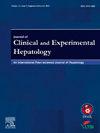亚洲成人非酒精性脂肪肝、酒精性脂肪肝和酒精性脂肪肝患病率与临床特征的比较
IF 3.3
Q2 GASTROENTEROLOGY & HEPATOLOGY
Journal of Clinical and Experimental Hepatology
Pub Date : 2024-10-08
DOI:10.1016/j.jceh.2024.102420
引用次数: 0
摘要
背景/目的非酒精性脂肪肝(NAFLD)一词的主要局限性在于依赖于排他性混杂因素术语和使用具有潜在侮辱性的语言。在三年内,非酒精性脂肪肝经历了两次更名,从非酒精性脂肪肝到代谢功能障碍相关性脂肪肝(MAFLD),再到代谢功能障碍相关性脂肪肝(MASLD)。然而,亚洲尚未就 MASLD 的重新命名达成共识,而且有关不同诊断标准下亚洲人群的流行病学和特征的证据仍然有限。本研究旨在通过分析亚洲人群中MASLD、NAFLD和MAFLD的患病率和特征来填补这些空白。方法在中国地区开展了一项回顾性横断面研究,参与者来自2017-2022年的健康管理数据库。获得了人口统计学、实验室代谢概况和身体成分数据。通过超声波诊断肝脏脂肪变性。采用非酒精性脂肪肝纤维化评分(NFS)评估肝纤维化的可能性。最近提出的代谢功能障碍相关性脂肪性肝病(MASLD)标准也被应用其中。7465人(36.91%)被归类为MASLD患者,10726人(53.03%)为MAFLD患者,7333人(36.26%)为NAFLD患者。与 MAFLD 相比,MASLD 和 NAFLD 患者的身体组成明显不同。与非MAFLD患者相比,MASLD患者年龄更大,体重指数和男性比例更高,谷丙转氨酶、舒张压、甘油三酯和腰围更高,但高密度脂蛋白胆固醇(HDL-C)更低。通过二元回归分析,我们首次发现推测骨量(OR = 4.62,95CI% 3.12-6.83)与罹患 MASLD 的风险有关。预测心血管后果(CV)的接收器操作曲线下面积(AUC)在 MAFLD 为 0.644,在 MASLD 为 0.701。推测骨量可能是MASLD患者疾病进展的预测因素。MASLD能更好地识别代谢紊乱或心血管事件风险较高的患者。本文章由计算机程序翻译,如有差异,请以英文原文为准。
Comparison of NAFLD, MAFLD, and MASLD Prevalence and Clinical Characteristics in Asia Adults
Background/Aims
The principal limitations of the term non-alcoholic fatty liver disease (NAFLD) are the reliance on exclusionary confounder terms and the use of potentially stigmatizing language. Within three years, NAFLD went through two name changes, from NAFLD to metabolic-dysfunction-associated fatty liver disease (MAFLD) to metabolic dysfunction-associated steatotic liver disease (MASLD). However, there is no Asian consensus statement on the renaming of MASLD, and evidence on the epidemiology and characteristics in the Asia population under different diagnostic criteria remain limited. This study aimed to fill these gaps by analyzing the prevalence and characteristics of MASLD, NAFLD, and MAFLD in an Asian population.
Methods
A retrospective, cross-sectional study was conducted in regional China with participants from the health management database in 2017–2022. Demographic and laboratory metabolic profile and body composition data were obtained. Hepatic steatosis were diagnosed by ultrasound. The likelihood of having fibrosis was assessed using the NAFLD fibrosis score (NFS). Recently proposed criteria for metabolic dysfunction-associated steatotic liver disease (MASLD) were applied.
Results
A total of 20,226 subjects were included for final analysis. 7465 (36.91%) participants were categorized as MASLD patients, 10,726 (53.03%) participants were MAFLD, and 7333 (36.26%) participants were NAFLD. Compared with MAFLD, body composition of MASLD and NAFLD patients were obviously different. MASLD patients were older, had a higher body mass index and percentage of male gender, and had a higher ALT, diastolic blood pressure, triglyceride, and waist circumference but lower High-Density Lipoprotein Cholesterol (HDL-C) than non-MASLD patients. Using binary regression analysis, we found for the first time that putative bone mass (OR = 4.62, 95CI% 3.12–6.83) is associated with the risk of developing MASLD. The area under the receiver operating curve (AUC) for predicting cardiovascular outcomes (CV) was 0.644 for MAFLD and 0.701 for MASLD.
Conclusion
MASLD (36.91%) prevalence was closed to NAFLD (36.26%) and lower than MAFLD (53.03%). Presumed bone mass might be the predictor of disease progression in MASLD patients. MASLD better identifies patients likely to have a higher risk of metabolic disorders or CV events.
求助全文
通过发布文献求助,成功后即可免费获取论文全文。
去求助
来源期刊

Journal of Clinical and Experimental Hepatology
GASTROENTEROLOGY & HEPATOLOGY-
CiteScore
4.90
自引率
16.70%
发文量
537
审稿时长
64 days
 求助内容:
求助内容: 应助结果提醒方式:
应助结果提醒方式:


